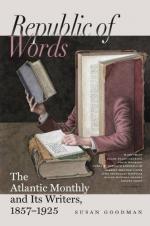The clouds had been gathering ominously during the latter half of our long day of travel,—and as the sun set blood-red behind a heavy bank of vapor, it cast lurid reflections on large bodies of dense mist, which sailed heavily athwart the crests of the mountains, with low, ragged, trailing edges, that were too surely the precursors of a storm. Just before the orb finally disappeared, its slant rays streamed through some dark purple bars on the horizon’s verge, and for an instant tinged the opposite distant mountains with strange supernatural hues. The Blorenge and the Sugar Loaf glowed like huge carbuncles, while the pale green light which bathed their bases gleamed faintly like a setting of aqua-marina. My artist companion incontinently fell into professional raptures, and raved of “effect,” and “Turner,” and “Ruskin,” heedless of my advice that he had better hasten onward, lest night should overtake us in that wild region, where sheep-tracks, scarcely visible even by daylight, were our sole guides. At length, however, I managed to start him, and on we stalked, the decreasing twilight and the distant reverberations of thunder among the mountains hastening our steps, until they became almost a trot.
But soon the trot declined once more into a walk, and a slow one too,—for we entered a gloomy pass or gorge, whose rocky walls on either side effectually excluded what little light yet lingered in the sky. Cautiously picking our way, we slowly travelled on, until at length we became sensible of a faint red flush in the narrow strip of sky overhead. It seemed as though the sun had just wheeled back to give a forgotten message to some starry-night-watcher,—or so my companion intimated. But, unfortunately for his theory, the dull red glare above us, which every moment deepened in intensity, was evidently the reflection of earthly, not heavenly fire. I had seen too many conflagrations to doubt that for an instant. Presently a dull, confused sound fell on our ears, and at a sudden turn round an angle of our mountain road we stood speechless as we gazed on a spectacle which Milton might have conceived and Martin painted.
“Far other light than that of day
there shone
Upon the wanderers entering Padalon,”
murmured the artist, as he gazed on the strange scene. And strange indeed was it to our startled eyes. We stood on the end and summit of a mountain spur, some two thousand feet above the valley, or rather basin, below, from the centre of which burst forth a thousand fires, whose dull roar—dulled by distance—was like “the noise of the sea on an iron-bound shore.” The extent of space covered by those strange, fierce fires must have amounted to many acres,—in fact, did so, as we afterwards ascertained,—and the effect produced by them may be partially imagined when it is remembered that these flames were of all hues, from rich ruby-red, to the pale lurid light of burning sulphur. Fancy all the gems of Aladdin’s Palace or Sinbad’s Valley in fierce flashing combustion, immensely magnified, and you may form some faint idea of the scene in that Welsh valley.




